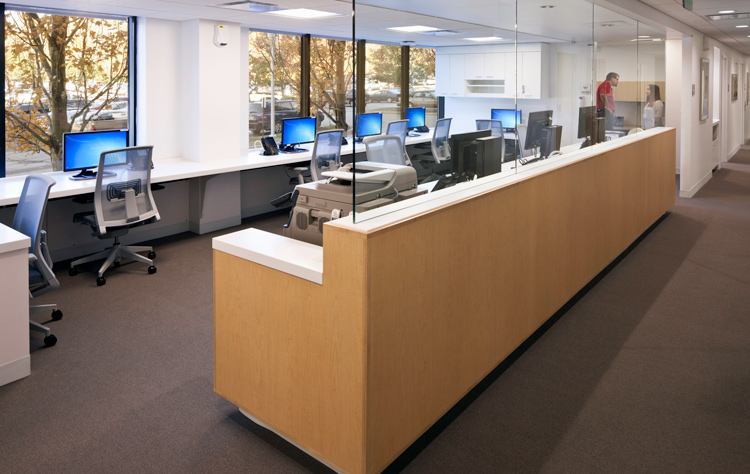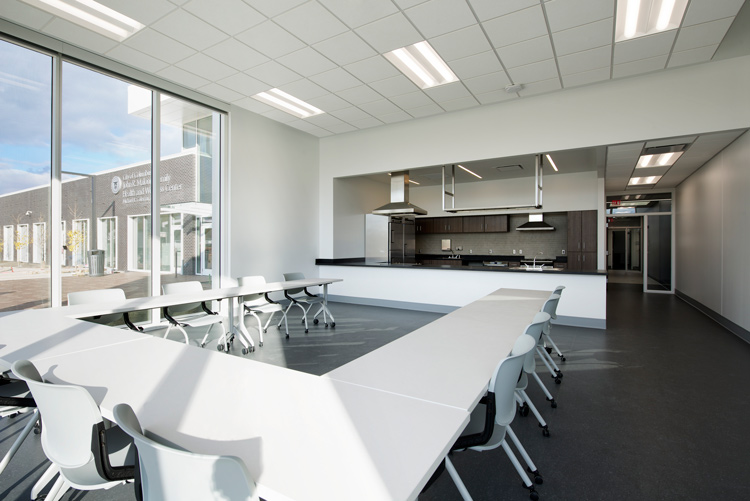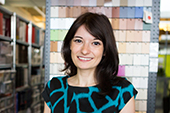A generational shift in healthcare consumer demands
Healthcare, like any business, evolves. Like the care itself, the space where care is provided changes with technology, the needs and dictates of society, and from generation to generation. By looking at one element of healthcare –the medical office building – we can trace how changes in design accommodate a changing society and its expectations from its health practitioners. Two healthcare designers, with distinct generational perspectives, weigh in on a medical landscape that is in flux.
Meeting the Needs of Patients Today
With greater focus now on the continuum of healthcare, medical office buildings are serving a new and broader role as part of a healthcare facility and can easily be viewed as equally important as the inpatient beds and procedural spaces found in the hospital proper. While a modular approach to planning is still valid, the module is being redefined.
Much of this has been enabled by the changing relationship between the hospital enterprise and physicians as the affordable care act and other socio-economic forces are heavily trending toward employed physician relationships. In many systems private physician offices have become a thing of the past in favor of hoteling or collaboration areas. These areas are also not reserved for physicians alone but include mid-level medical staff, nursing staff and ancillary consultants. Dollars are focused on the clinical space.

Likewise, the nature of the exam room is also changing. The spaces are somewhat larger and are being increasingly standardized with variations only as some specialty patients such as orthopedics or bariatrics may demand. The expected typical equipment and furnishings may be different as well with some exams not requiring the patient to disrobe and lay down but instead a conversation in a consult or “talking” room. These spaces may be customized for the type of visit, being smaller for the quick, single-issue visits and larger to allow for more complex care and additional family members.
The slow but continued acceptance of group visits also demands that larger interaction spaces are provided in the MOB. Often called Shared Medical Appointments, this approach is ideal for groups focused on the treatment of some chronic conditions such as diabetes, asthma or hypertension. Traditional MOB design has not supported this approach to care in the past.

Also at play is the extremely fast paced development of technology that is helping to speed and improve the patient visit when coming to a physical facility but also allowing patients to access medical care from their home or office. Generational preferences can come into play with the first of the baby boomers now turning 70. The expectation of a high level of service and convenience is a well-documented characteristic of this generation but many boomers struggle with complete mastery of the technology available to them.
The Reality of Virtual Visits
Telemedicine apps are now a basic component of many health insurance plans. For instance, the app HealthiestYou places the MOB into your smart phone, offering 2,300 doctors via video or voice connection. In theory, young professionals can sneak into a conference room over lunch, shut the door, and snag a prescription for their sore throats in five minutes.
Telemedicine suggests that the future of the basic doctor’s visit will entail the Wi-Fi hotspot in an airport where you waste no time video conferencing with a pixelated doctor in between business trips. Telemedicine apps direct us away from the physical hassle of wasting hours in the work day and sitting in potentially stressful, germ-infested waiting rooms. They offer a portal to good health with the comfortable premise that we are in control of the time and place in which we receive diagnoses.
Technology opens us to efficiency at its finest. It also may close us off to forming a relationship with our doctors. With 2,300 physicians scrambling to advise you on your stubbed toe, it is unlikely that you will call back and get the same one who is so intimately familiar with that toe when that toe becomes infected.
A patient on the trailing end of the baby boomer generation might empathize with the overwhelming task of utilizing all of the technology available to its full ability. Technology such as online appointments and access to medical information via a portal at their primary care physician’s office are a great convenience and fit their comfort level. The patient may not want to part with the face to face conversation and exam with my physicians. Likewise, they may see value in seeing “their doctor” at an office visit probably imagining that she remembers them and not fully realizing her dependence on electronic record for medical history and connectivity to any needed specialists.
But what happens going forward when the generations that have grown up with the internet, apps, and an ever-changing array of mobile technology are the driving force and have differing demands for care?
More Than a Mobile Device, a Mobile Center
A millennial may envision a world where truck drivers can pause their deliveries to park at a rest stop for an employer mandated drug test. Or, where the baby boomer couple traveling the country in their RV can stop at a retail outlet for a physical on their way to the Grand Canyon. Or, even a world where the end of the drive-through liquor store has a doctor ready to poke at your liver.People don’t have disposable time anymore. Our time is expensive. If we can squeeze in a medical visit as part of our weekly errands, we are inclined to take full advantage of it. Its convenience may even coerce us to get the small problems checked out before they turn into big problems. Studio Dental is a standout case of the quick-stop doctor’s appointment. The San Francisco-based dental-clinic-in-a-trailer that travels to different office parking lots has been touted an “Uber for your teeth.” [ 1 ] Purposefully, the business targets young professionals whose time is valuable. Studio Dental’s clients are the millennials who find a 20-minute roundtrip drive to the dentist, plus a 15 minute wait, plus an hour long appointment, to be a heavy inconvenience – and rightfully so, in this era.
The clinic is indubitably inspired by the concept of mobile doctors. For instance, the Children’s Health Fund [ 2 ] in New York City owns a mobile unit that travels to impoverished neighborhoods. Their objective is to care for children that would not otherwise visit the doctor. The design of the clinic almost presents itself as a caricature. The “nurses’ station” is stripped down to a counter storing all the bare necessities, the waiting area hilariously refers to a passenger seat, and the procedures room leaves much to the imagination as to what may be performed there. And yet, we should be taking this model seriously – healthcare is moving toward it.
So, if we are going to over-convenience today’s generation, why not consider reworking the most basic healthcare model: the medical office building? MOBs cohere medical offices, offices that often have little more to do with each other than the concept of a doctor’s visit, into a single box. Easily enough, the parts of the MOB can be dissected and craftfully placed alongside unrelated programs that can enhance their interest. Let’s follow the Studio Dental model and bring the doctors to the people. Let’s put doctors’ offices in hotels and airports, where professionals can stop in for a checkup and attend meetings afterwards with a clean bill of health. Let’s rename the MOB to the MOQ: Medical Office Quick-Stop.
The human connection with our doctors is slipping away, but we can salvage the best parts of it. The MOQ model is certainly quicker and easier. It may open the possibility of hopping between different conveniently located doctors for multiple opinions. It can also be there if you decide you want to see the same doctor in a couple of months on your way home from the grocery store.The pop-up mini-clinic is a plausible next step in the world of medicine. But the step thereafter is one that both baby boomer and millennial generations alike would dread: the demise of healthcare architecture.
The Future is Now
It is likely that the MOB as a physical site will be around to stay for another 20 or 30 years while the baby boomers still influence the way medical care is accessed. Phone apps, telemedicine, online registration and information access will undoubtedly continue to evolve but remain rooted in some of the current practices to accommodate those in a more tech-savvy generation. Yet there is a rift evolving in our society. We are growing increasingly disconnected from our healthcare providers. Grocery stores are moving into the realms of “minute clinics,” where patients can be diagnosed with minor afflictions over the course of a lunch break. Big box stores are now welcoming optometry offices. We are in the midst of a culture in which you can buy new shoes, pick up bread and find out that you have cataracts all in the same trip.There is an in-between: amidst the circuitous, maze-like floor plans of today’s MOBs and the airport diagnosis, we have an opportunity.
On-the-go architecture can gift us with the happy medium between the permanence of buildings and the impermanence of the fleeting digital connection. With the MOQ, your doctor is still there if you need them again – they just inhabit a less permanent space. The MOQ is the solution to the rift between permanent and temporary. Perhaps the old formulaic 30’x30’ MOB grid can shift into a 10’x10’ MOQ module. The module can inhabit spaces that would otherwise be reserved for a private office, or a store at the mall, or an aisle at the store. Perhaps its finishes are too temporary to ever become stale, and its physical footprint is too tiny to be circuitous. Maybe modernism goes hand in hand with micro-spaces that serve our basic needs in the refuge of a 10’x10’ box tucked among the many stops of our fast paced lives.

Jane Peters // Principal, Senior Healthcare Planner
Jane earned her Master of Architecture from Harvard University Graduate School of Design and has dedicated over 27 years to providing medical planning and architectural design services for healthcare organizations throughout the country.
Jane's healthcare planning expertise includes the recently completed 50,000 SF medical office building for Butler Health System.

Yana Grinblat // Project Associate
Yana brings a fresh, young perspective to design to her position as Project Associate. Trained in architecture, she offers a do-it-all approach with her passion for interior spaces. Her interest lies in the most minute details and sensitive moves that bring out emotion. Yana is particularly interested in healthcare architecture, she strives to advance the field and hone her expertise in crafting spaces that offer comfort and inspire celebration.
References: 1. [http://www.fastcoexist.com/3020141/futurist-forum/an-uber-for-your-teeth...↩ 2. [http://www.childrenshealthfund.org/healthcare-for-kids/doctors-office-on...↩
